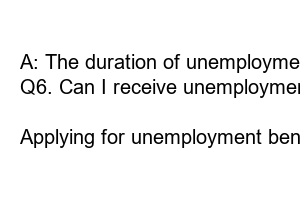실업급여 신청방법
Title: How to Apply for Unemployment Benefits: A Comprehensive Guide
Introduction:
Losing a job can be a stressful experience, but understanding how to apply for unemployment benefits can provide some financial relief during this difficult period. In this blog post, we will walk you through the step-by-step process to apply for unemployment benefits, ensuring you have all the necessary information to navigate the system successfully and minimize the stress.
Subheading 1: Gather the Required Documentation
Before you start the application process, it’s vital to gather the necessary documentation. This usually includes proof of identification, such as your social security number, driver’s license, or passport. Additionally, you may need to provide recent pay stubs, details about your previous employers, your employment history, and any other related documents. Having these ready will make the application process smoother.
Subheading 2: Determine Your Eligibility
Understanding your eligibility for unemployment benefits is crucial. While specific criteria may vary by state, generally, you will need to demonstrate that you lost your job through no fault of your own, meet certain work and wage requirements, and be actively seeking employment during your benefit period. Make sure you carefully review your state’s eligibility requirements to ensure you qualify.
Subheading 3: File for Unemployment Benefits
Once you have gathered all the necessary documents and confirmed your eligibility, it’s time to file for unemployment benefits. Most states allow you to file online, by phone, or in person. Online filing is often the most convenient option, as it allows for quick submission and eliminates the need to wait in long queues or spend time travelling.
Subheading 4: Provide Accurate Information
When filing your application, it’s crucial to provide accurate and complete information. Double-check all the details, including your employment history, dates of employment, and reasons for separation. Providing incorrect information may lead to delays or even denial of benefits. If you have any doubts, consult the guidelines provided by your state’s unemployment agency or reach out for assistance.
Subheading 5: Understand the Waiting Period and Benefit Payments
Once your application is submitted, there is typically a waiting period during which your eligibility is determined. This waiting period varies by state but is usually around two weeks. After this period, if approved, you will start receiving benefit payments. Familiarize yourself with your state’s payment methods and frequency, as well as any additional requirements, such as timely filing of your continued claims.
Subheading 6: Seek Reemployment Assistance
While receiving unemployment benefits, it is essential to actively seek reemployment. Many states require you to document your job search activities regularly. This could involve applying for jobs, attending career fairs, or participating in job training programs. Failure to meet these requirements may result in the suspension or termination of your benefits.
FAQs:
Q1. How long does it take to receive unemployment benefits after applying?
A: The processing time varies by state, but it typically takes around two to three weeks to receive your first benefit payment if approved.
Q2. Can I apply for unemployment benefits if I was laid off due to COVID-19?
A: Yes, many states have expanded their unemployment programs to include individuals affected by the pandemic.
Q3. What should I do if my application for unemployment benefits is denied?
A: If your application is denied, you have the right to appeal. Follow the instructions provided by your state’s unemployment agency for the appeal process.
Q4. Can I work part-time while receiving unemployment benefits?
A: In most cases, you can work part-time while receiving benefits, but the amount you earn might affect the amount of benefits you receive. Refer to your state’s guidelines for specific details.
Q5. How long can I receive unemployment benefits?
A: The duration of unemployment benefits varies by state. Typically, it ranges from 12 to 26 weeks.
Q6. Can I receive unemployment benefits if I quit my job voluntarily?
A: Generally, unemployment benefits are designed for individuals who lost their job through no fault of their own. If you voluntarily quit your job, you may not be eligible for benefits, but exceptions may exist. Check your state’s guidelines for specific information.
Summary:
Applying for unemployment benefits doesn’t need to be overwhelming. By gathering the necessary documentation, understanding eligibility requirements, filing the application accurately, and actively seeking reemployment, you can confidently navigate the process. Remember, each state has its own guidelines, so consult your local unemployment agency for specific details. Stay positive, stay persistent, and utilize the available resources to help ease your financial burden during this challenging time.

